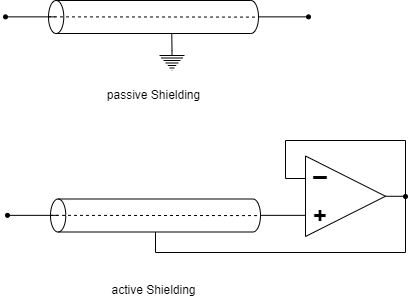Exercise 3.3.1 Analysis of the impedance converter circuit with different operational amplifiers
Imagine that you work in the company „HHN Mechatronics & Robotics“, which is a cheap mobile EKG – So you want to build a measuring device for the electrocardiogram or the cardiac voltage curve - for athletes and those in need. The measurement signal has only a few millivolts and microamps. In order to protect the signal from electromagnetic radiation on the way from the glued-on electrode to the evaluation electronics, a electromagnetic shielding placed around the line (see Abbildung 1, above). However, since this creates a parasitic capacitor, a colleague suggested active shielding. The shielding is always kept at the measuring voltage that is applied to the line via a voltage follower (see Abbildung 1, under). The parasitic capacitor is never charged due to this structure, since the same voltage prevails on both sides - there is no falsification of the signal. It is important for the application that the voltage follower reacts quickly.
You are supervised with the design of this voltage follower and should use the available operational amplifiers $\rm LM318$, $\rm uA741$, and $\rm uA776$ analyze in the voltage follower circuit.
Write a short report (problem description, circuit in TINA TI, results, discussion) and use TINA TI for the solution.
- Recreate the circuit described above for a realistic operational amplifier in Tina. Use a voltage generator as a source unit step with the amplitude $U_\rm A = 1.0 ~\rm V$.
- Simulate over
Analysis»Transient…the time course for the specified operational amplifiers.
Determine the time that elapses until the initial value of $0.1 ~\rm V$ for the first time $0.9 ~\rm V$ achieved ($10~\rm %$ to $90 ~\rm %$ of the amplitude, too. It is called rise time). - Describe the passage of time in each case. Are there any other differences besides the rise time?
- Based on the information provided, which of the three op amps would you choose for the problem?
In-depth information (not relevant to the exercise):
- Detailed description of a EMG/EKG Vorverstärkerschaltung
